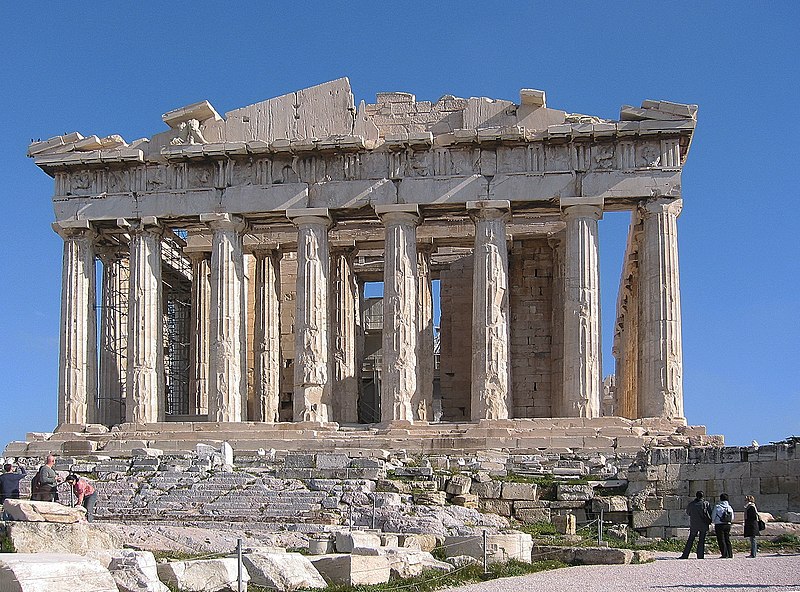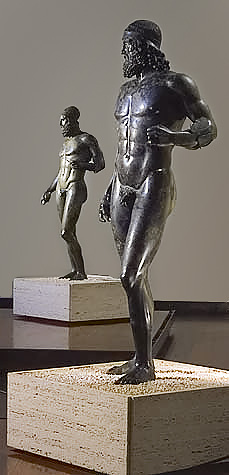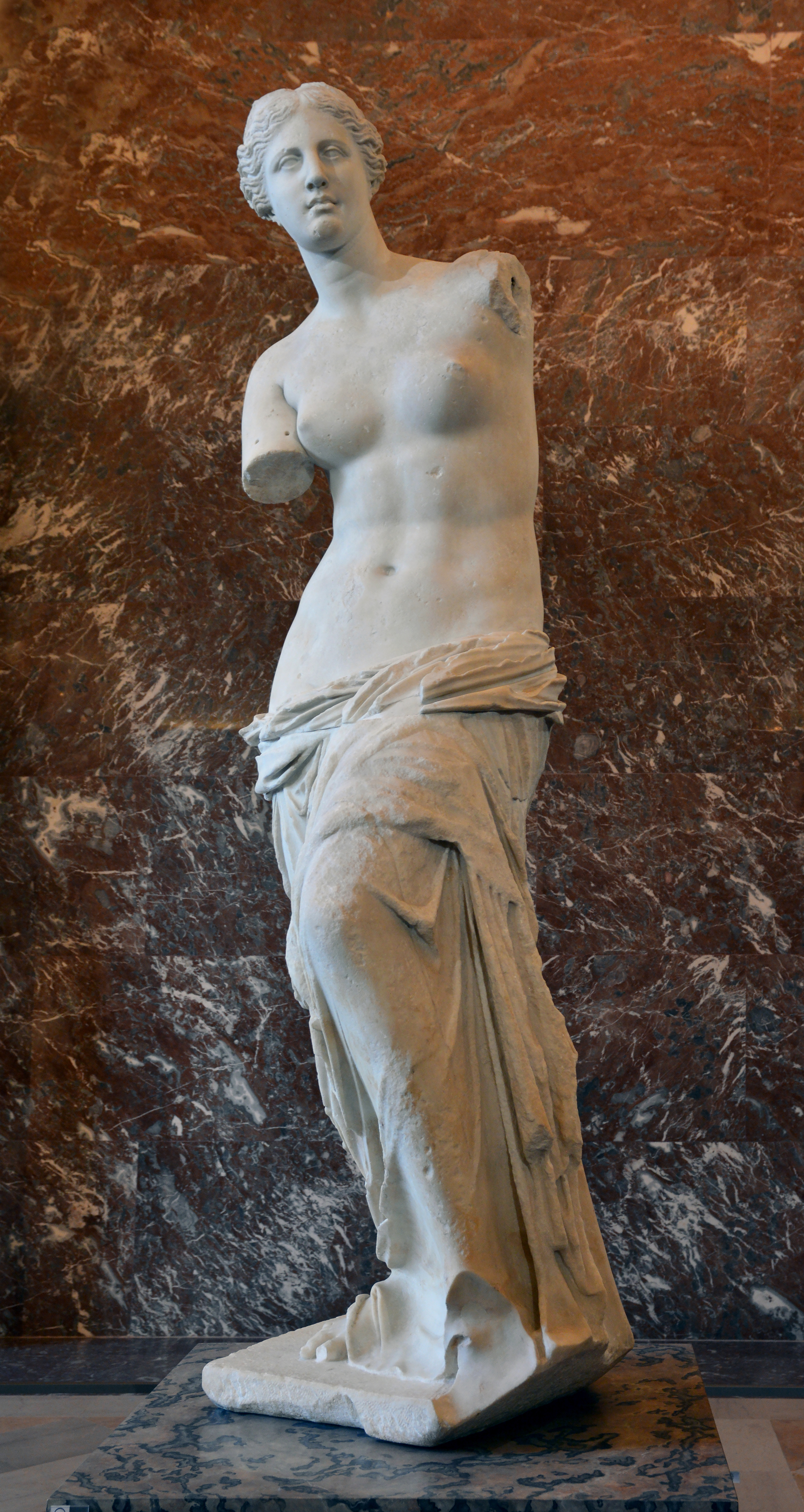The arts reflect the society that creates them. Nowhere is this truer than in the case of the ancient Greeks. Through their temples, sculpture, and pottery, the Greeks incorporated a fundamental principle of their culture: arete. To the Greeks, arete meant excellence and reaching one’s full potential.
Ancient Greek art emphasized the importance and accomplishments of human beings. Even though much of Greek art was meant to honor the gods, those very gods were created in the image of humans.
Pottery/Painting
The ancient Greeks painted, but very little of their work remains. The most enduring paintings were those found decorating ceramic pottery. Two major styles include red figure (against a black background) and black figure (against a red background) pottery. The pictures on the pottery often depicted heroic and tragic stories of gods and humans.
Vases, vessels, and kraters served both practical and aesthetic purposes. Much artwork was government sponsored and intended for public display.

This krater depicts Helios, the sun god, and dates from the 5th century B.C.E.
The Niobid Painter’s red-figure krater of Artemis and Apollo slaying the children of Niobe, from 460 BCE, is believed to be a composition inspired by a panel painting. The side of the vessel depicting Artemis and Apollo relates to the myth of the twin god and goddess who slew Niobe’s fourteen children after she boasted that her ability to birth children exceeded Leto, the mother of Apollo and Artemis.

Herakles with Gods and Heroes: Painted by the Niobid Painter. The reverse side of the krater depicts Artemis and Apollo slaying the children of Niobe. An Athenian red-figure calyx krater, c. 450 BCE, Orvieto, Italy.
This story alludes to ancient Greek admonitions against hubris, or extreme pride. The scene is one of the first vase painting scenes to show the figures on different ground lines. Apollo and Artemis stand in the center of the vessel as Niobe’s children fall to ground around them. One child has even fallen behind a rock in the landscape.
On the other side of the vase is an image of gods and heroes, with Herakles at the center. All the figures stand and sit on various ground lines. The figures on both sides are depicted from multiple angles, including three-quarter view, and a profile eye is used for the figures in profile, a first in Greek vase painting.

Artemis and Apollo Slaying the Children of Niobe: Painted by the Niobid Painter on an Athenian red-figure calyx krater, c. 450 BCE, from Orvieto, Italy.
Architecture
The great legacy of Greek art is in its celebration of perfection and balance: the human body in its perfect state, perfect symmetry in buildings, and balance in geometric forms. One well known instance of this was in architecture, with the use of a mathematical concept known as the “golden ratio” (also known as the “golden mean”) which, when applied to building, creates forms that the Greeks, and many others afterwards, believed was inherently pleasing to the eye.
A Rational Approach
The ancient Greeks were the first Western culture that believed in finding rational answers to the great questions of earthly life. They assumed that there were consistent laws which governed the universe—how the stars move; the materials that compose the universe; mathematical laws that govern harmony and beauty, geometry and physics….
[T]he Ancient Greeks had enormous respect for human beings, and what they could accomplish with their minds and bodies. They were Humanists (a frame of mind which was re-born in the Renaissance). This was very different from the period following Classical Antiquity—the Middle Ages, when Christianity (with its sense of the body as sinful) came to dominate Western Europe.
Greek architecture is important for several reasons:
- Because of its logic and order. Logic and order are at the heart of Greek architecture. The Hellenes planned their temples according to a coded scheme of parts, based first on function, then on a reasoned system of sculptural decoration. Mathematics determined the symmetry, the harmony, the eye’s pleasure. There had never been an architecture in just this sense. Egyptian pyramid architecture had been an early, attempt, but Greek building art offered the first clear, strong expression of a rational, national architectural creed. It is the supreme example of the intellect working logically to create a unified aesthetic effect. Greek designers used precise mathematical calculations to determine the height, width and other characteristics of architectural elements. These proportions might be changed slightly, and certain individual elements (columns, capitals, base platform), might be tapered or curved, in order to create the optimum visual effect, as if the building was a piece of sculpture.
- Because of its invention of the classical “orders”: namely, namely, the Doric Order, the Ionic Order and the Corinthian Order – according to the type of column, capital and entablature used.
- Because of its exquisite architectural sculpture. Architects commissioned sculptors to carve friezes, statues and other architectural sculptures, whose beauty has rarely, if ever, been equaled in the history of art.
- Because of its influence on other schools. Although Greek architects rarely progressed further than simple post-and-lintel building techniques, and failed to match the engineering techniques (arch, vault) developed in Roman architecture, they succeeded in creating the most beautiful, monumental structures of the Ancient World. Their formulas – devised as far back as 550 BCE – paved the way for Renaissance and Neoclassical architecture, and had the greatest possible influence on the proportions, style and aesthetics of the 18th and 19th centuries. Modern architects, too, have been influenced by Greek architectural forms. Louis Sullivan (1856-1924), for instance, a leading figure in the First Chicago School, based a number of his skyscraper designs on the Greek template of base, shaft, and capital, while using vertical bands (reminiscent of the fluting on Greek columns) to draw the eye upwards.
Greek Excellence: The Acropolis
Art and architecture were a tremendous source of pride for citizens and could be found in various parts of the city. Typically, a city-state set aside a high-altitude portion of land for an acropolis, an important part of the city-state that was reserved for temples or palaces. The Greeks held religious ceremonies and festivals as well as significant political meetings on the acropolis.
The most prominent surviving piece of Greek architecture, the Parthenon of Athens dedicated to Athena, the polis’s patron goddess of wisdom for whom the city-state Athens was named, was built to embody the golden ratio in terms of its height and width. Likewise, in its use of symmetrical columns and beautiful carvings, it is widely believed to strike a perfect balance between elegance and grandeur.

Contemporary view of the Parthenon
The Parthenon is a marvel of design, featuring massive columns contrasting with subtle details.
Doric, Ionic, and Corinthian Orders

Three different types of columns can be found in ancient Greek architecture. Whether the Doric, Ionic, or Corinthian style was used depended on the region and the purpose of the structure being built.
Three different types of columns can be found in ancient Greek architecture. Whether the Doric, Ionic, or Corinthian style was used depended on the region and the purpose of the structure being built.
Many barely noticeable enhancements to the design of the Parthenon contribute to its overall beauty and balance. For example, each column is slightly wider in the middle than at its base and top. The columns are also spaced closer together near the corners of the temple and farther apart toward the middle. In addition, the temple’s steps curve somewhat — lower on the sides and highest in the middle of each step.
Sadly, time has not treated the Parthenon well. In the 17th century, the Turks, who had conquered the Greeks, used the Parthenon to store ammunition. An accidental explosion left the Parthenon with no roof and in near ruin. In later years, tourists hauled away pieces of the Parthenon as vacation souvenirs.
Sculpture and Beauty in Human Form
In turn, Greek sculpture is renowned for its unflinching commitment to perfection in the human form. The classical period saw a transition away from symbolic statuary, most of which was used in grave decorations in the Archaic period, toward lifelike depictions of real human beings. In turn, classical statues often celebrated the human potential for beauty, most prominently in nude sculptures of male warriors and athletes at the height of physical strength and development. Greek sculptors would often use several live models for their inspiration, combining the most attractive features of each subject to create the “perfected” version present in the finished sculpture – this was artistic humanism in its purest form.
Most Greek art was destroyed over time, not least because the dominant medium for sculpture was bronze, which had allowed sculptors great flexibility in crafting their work. As Greece fell under the domination of other civilizations and empires in the centuries that followed, almost all of those bronzes were melted down for their metal. Fortunately, the Romans so appreciated Greek art that they frequently made marble copies of Greek originals. We thus have a fair number of examples of what Greek sculpture looked like, albeit in the form of the Roman facsimiles. Likewise, the Romans copied the Greek architectural style and, along with the Greek buildings like the Parthenon that did survive, we are still able to appreciate the Greek architectural aesthetic.
For the most part, the Greeks created their free-standing sculpture in bronze, but because bronze is valuable and can be melted down and reused, sculpture was often recast into weapons. This is why so few ancient Greek bronze originals survive, and why we often have to look at ancient Roman copies in marble (of varying quality) to try to understand what the Greeks achieved.
Early Greek statues called kouros were rigid and stood up straight.

One of the few original Greek bronze statues to survive, depicting either Zeus or Poseidon (Zeus would have held a lightning bolt, Poseidon a trident).
Over time, Greek statuary adopted a more natural, relaxed pose with hips thrust to one side, knees and arms slightly bent, and the head turned to one side.

Riace bronzes, examples of proto classic bronze sculpture, Museo Nazionale della Magna Grecia, Reggio Calabria
Other sculptures depicted human action, especially athletics. A good example is Myron’s Discus Thrower. Another famous example is a sculpture of Artemis the huntress. The piece below, called “Diana of Versailles,” is a Roman depiction of Artemis reaching for an arrow while a stag leaps next to her.

The Diana of Versailles in the Louvre Galerie des Caryatides that was designed for it
Among the most famous Greek statues is the Venus de Milo, which was created in the second century B.C.E. The sculptor is unknown, though many art historians believe Praxiteles to have created the piece. This sculpture embodies the Greek ideal of beauty.

Venus de Milo on display at the Louvre
Candela Citations
- Reading: Ancient Greece and Rome. Provided by: Lumen Learning. Located at: https://courses.lumenlearning.com/masteryart1/chapter/reading-ancient-greece-and-rome/. License: CC BY-SA: Attribution-ShareAlike
- Art. Authored by: Christopher Brooks. Provided by: LibreTexts. Located at: https://human.libretexts.org/Bookshelves/History/World_History/Book%3A_Western_Civilization_-_A_Concise_History_I_(Brooks)/07%3A_The_Classical_Age_of_Greece/7.06%3A_Art. License: CC BY-NC-SA: Attribution-NonCommercial-ShareAlike
- The Diana of Versailles in the Louvre Galerie des Caryatides that was designed for it. Provided by: Wikimedia Commons. Located at: https://en.wikipedia.org/wiki/Diana_of_Versailles#/media/File:Diane_de_Versailles_Leochares_2.jpg. License: CC BY-SA: Attribution-ShareAlike
- Venus de Milo on display at the Louvre. Provided by: Wikimedia Commons. Located at: https://en.wikipedia.org/wiki/Venus_de_Milo#/media/File:Front_views_of_the_Venus_de_Milo.jpg. License: CC BY-SA: Attribution-ShareAlike
- Greek Architecture (c.900-27 BCE). Authored by: Neil Collins . Provided by: Encyclopedia of Art. Located at: http://www.visual-arts-cork.com/architecture/greek.htm. License: All Rights Reserved
- Art and Architecture. Authored by: Boundless. Provided by: ushistory.org. Located at: http://dev.ushistory.org/civ/5e.asp. License: Public Domain: No Known Copyright
- Riace bronzes, examples of proto classic bronze sculpture, Museo Nazionale della Magna Grecia, Reggio Calabria. Provided by: Wikimedia Commons. Located at: https://en.wikipedia.org/wiki/Ancient_Greek_sculpture#/media/File:Reggio_calabria_museo_nazionale_bronzi_di_riace.jpg. License: Public Domain: No Known Copyright
- The Early Classical Period. Provided by: Lumen Learning. Located at: https://courses.lumenlearning.com/boundless-arthistory/chapter/the-early-classical-period/. License: CC BY-SA: Attribution-ShareAlike
